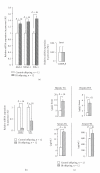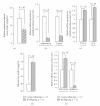A model of insulin resistance in mice, born to diabetic pregnancy, is associated with alterations of transcription-related genes in pancreas and epididymal adipose tissue
- PMID: 20936114
- PMCID: PMC2948918
- DOI: 10.1155/2011/654967
A model of insulin resistance in mice, born to diabetic pregnancy, is associated with alterations of transcription-related genes in pancreas and epididymal adipose tissue
Abstract
Objective. This study is conducted on a model of insulin-resistant (IR) mice born to dams which were rendered diabetic by the administration of streptozotocin. Methods. Adult IR and control offspring were selected and we determined the mRNA expression of transcription factors known to modulate pancreatic and adipose tissue activities and inflammation. Results. We observed that serum insulin increased, and the mRNA of insulin gene transcription factors, Pdx-1, Nkx6.1 and Maf-A, were upregulated in IR mice pancreas. Besides, their pancreatic functional capacity seemed to be exhausted as evidenced by low expression of pancreatic Glut2 and glucokinase mRNA. Though IR offspring exhibited reduced epididymal adipose tissue, their adipocytes seemed to be differentiated into macrophage-like cells, as they exhibited upregulated CD14 and CD68 antigens, generally expressed by macrophages. However, there was no peripheral macrophages infiltration into epididymal adipose tissue, as the expression of F4/80, a true macrophage marker, was undetectable. Furthermore, the expression of IL-6, TNF-α and TLR-2, key players of insulin resistance, was upregulated in the adipose tissue of IR offspring. Conclusion. Insulin resistant state in mice, born to diabetic pregnancy, alters the expression of function-related genes in pancreas and epididymal adipose tissue and these offspring are prone to develop metabolic syndrome.
Figures




Similar articles
-
Peroxisome proliferator-activated receptor-alpha modulates insulin gene transcription factors and inflammation in adipose tissues in mice.Mol Cell Biochem. 2009 Mar;323(1-2):101-11. doi: 10.1007/s11010-008-9968-1. Epub 2008 Nov 28. Mol Cell Biochem. 2009. PMID: 19039651
-
Maternal Protein Restriction Altered Insulin Resistance and Inflammation-Associated Gene Expression in Adipose Tissue of Young Adult Mouse Offspring in Response to a High-Fat Diet.Nutrients. 2020 Apr 16;12(4):1103. doi: 10.3390/nu12041103. Nutrients. 2020. PMID: 32316103 Free PMC article.
-
Combined effects of rosiglitazone and conjugated linoleic acid on adiposity, insulin sensitivity, and hepatic steatosis in high-fat-fed mice.Am J Physiol Gastrointest Liver Physiol. 2007 Jun;292(6):G1671-82. doi: 10.1152/ajpgi.00523.2006. Epub 2007 Feb 22. Am J Physiol Gastrointest Liver Physiol. 2007. PMID: 17322064
-
Differentiation of human adipose tissue-derived stem cells into aggregates of insulin-producing cells through the overexpression of pancreatic and duodenal homeobox gene-1.Cell Transplant. 2013;22(6):1053-60. doi: 10.3727/096368912X657215. Epub 2012 Oct 1. Cell Transplant. 2013. PMID: 23031216
-
Adipocyte-Macrophage Cross-Talk in Obesity.Adv Exp Med Biol. 2017;960:327-343. doi: 10.1007/978-3-319-48382-5_14. Adv Exp Med Biol. 2017. PMID: 28585206 Review.
Cited by
-
Reducing effect of insulin resistance on alpha-synuclein gene expression in skeletal muscle.Diabetol Metab Syndr. 2019 Dec 2;11:99. doi: 10.1186/s13098-019-0499-6. eCollection 2019. Diabetol Metab Syndr. 2019. PMID: 31827624 Free PMC article.
-
Peripheral blood gene expression profiles in metabolic syndrome, coronary artery disease and type 2 diabetes.Genes Immun. 2011 Jul;12(5):341-51. doi: 10.1038/gene.2011.13. Epub 2011 Mar 3. Genes Immun. 2011. PMID: 21368773 Free PMC article.
-
Reversal of type 1 diabetes in mice by brown adipose tissue transplant.Diabetes. 2012 Mar;61(3):674-82. doi: 10.2337/db11-0510. Epub 2012 Feb 7. Diabetes. 2012. PMID: 22315305 Free PMC article.
-
Severe maternal hyperglycemia exacerbates the development of insulin resistance and fatty liver in the offspring on high fat diet.Exp Diabetes Res. 2012;2012:254976. doi: 10.1155/2012/254976. Epub 2012 Apr 12. Exp Diabetes Res. 2012. PMID: 22566993 Free PMC article.
-
Maternal diabetes in pregnancy: early and long-term outcomes on the offspring and the concept of "metabolic memory".Exp Diabetes Res. 2011;2011:218598. doi: 10.1155/2011/218598. Epub 2011 Nov 21. Exp Diabetes Res. 2011. PMID: 22144985 Free PMC article. Review.
References
-
- Guillausseau P-J, Laloi-Michelin M. Pathogenesis of type 2 diabetes mellitus. Revue de Medecine Interne. 2003;24(11):730–737. - PubMed
-
- Pagliassotti MJ, Knobel SM, Shahrokhi KA, Manzo AM, Hill JO. Time course of adaptation to a high-fat diet in obesity-resistant and obesity-prone rats. American Journal of Physiology. 1994;267(3):R659–R664. - PubMed
-
- Buettner R, Schölmerich J, Bollheimer LC. High-fat diets: modeling the metabolic disorders of human obesity in rodents. Obesity. 2007;15(4):798–808. - PubMed
-
- Yessoufou A, Soulaimann N, Merzouk SA, et al. N-3 fatty acids modulate antioxidant status in diabetic rats and their macrosomic offspring. International Journal of Obesity. 2006;30(5):739–750. - PubMed
-
- Merzouk H, Madani S, Hichami A, Prost J, Belleville J, Khan NA. Age-related changes in fatty acids in obese offspring of streptozotocin-induced diabetic rats. Obesity Research. 2002;10(7):703–714. - PubMed
LinkOut - more resources
Full Text Sources
Research Materials

